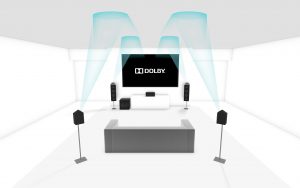SVG Europe Sit-Down: Dolby’s Rob France considers challenges of 2018 and directions for audio-over-IP
Dolby is continually advancing the sciences of imaging and sound for an evolving broadcast world. It creates innovative and practical end-to-end solutions that are designed to meet the growing expectations of consumers.
Dolby’s technology both expands users’ capabilities and simplifies workflows. Its technologies are designed to deliver the immersive and personalised audio that customers will expect in the future. However, our discussion with Senior Product Marketing Manager, Consumer Entertainment Group, Rob France, began with a reflection on 2017.
Looking back, how were the business activities of Dolby in 2017 compared to 2016?
We continued to build momentum with bringing our new audio-visual experiences to market. We increased adoption of Dolby Vision in TVs and mobile devices, broadening our portfolio across a range of price points and devices with leading global partners such as Apple and Vestel, the largest TV manufacturer in Europe.

Dolby senior product marketing manager Rob France
On the audio side, there has been strong adoption of Dolby Atmos in devices, content and services. In 2017, we reached a major milestone when BT Sport and Sky enabled consumers to experience live sports in Dolby Atmos including the English Premier League and Champions League.
Last year was also a landmark year for Dolby AC-4, delivering immersive and personalised next-generation audio. Dolby AC-4 was widely deployed in retail televisions, becoming an integral feature of every Dolby Atmos TV. Dolby AC-4 has also been on-air across Europe and over 20 countries worldwide via broadcast and OTT.
With a growing pipeline of content for Dolby Atmos and Dolby Vision across all genres including live production, we’re in a strong position to bring Dolby experiences to even more consumers in 2018.
Looking forward, what are your challenges for 2018?
We are focused on delivering new audio-visual experiences and driving adoption of Dolby’s technologies across devices, content and services. With Dolby Atmos live on air in the UK, and following several successful live broadcast trials of major sporting events in Dolby Vision, we want to build on this momentum.
The challenge is how to take broadcasting and the entertainment experience to the next level. We are committed to working with our partners to deliver premium content and the best possible TV viewing experience for sports fans around the world.
The sporting world is pushing the technology boundaries when it comes to live production. With major sporting events this year going to be delivered with 4K video and immersive sound, Dolby’s technologies will be setting the standard and expectation for both the industry and consumers. It’s an exciting time with a lot to play for.
What were the considerations when it came to the implementation of Dolby Atmos for the latest Premier League season coverage?
With BT Sport having delivered its Premier League coverage in Dolby Atmos since January 2017, it was very much a case of business as usual. Dolby Atmos is now embedded in their productions and being delivered by the regular production teams. However, Sky launched on a larger number of games each week and had the particular challenge of delivering the Sunday double headers, where Dolby Atmos is being mixed at one stadium, but being sent across to another stadium for integration with the studio show. This was the first deployment where decoding was required for these feeds and a number of the NEP trucks had to be equipped with additional Dolby equipment to handle these feeds.
Another notable challenge with the increase in games is the wider range of stadiums that are now  being covered in Dolby Atmos. As with stereo and 5.1, some stadiums are more challenging than others when it comes to capturing great sound, and some crowds are livelier than others. Making sure the Dolby Atmos experience comes across from all stadiums, with the full impact and quality that we’d expect, is something that will continue to be refined throughout the season.
being covered in Dolby Atmos. As with stereo and 5.1, some stadiums are more challenging than others when it comes to capturing great sound, and some crowds are livelier than others. Making sure the Dolby Atmos experience comes across from all stadiums, with the full impact and quality that we’d expect, is something that will continue to be refined throughout the season.
Has the increase in remote production for sports events had an impact on the way Dolby technology will develop?
While lowering production costs is often one of the main justifications given, we frequently hear that delivering consistent experiences is a primary reason that many broadcasters are investigating in remote production. In many ways, the production of Dolby Atmos is no different whether it’s done on site or remotely. As long as the necessary mic feeds can be brought back, then the production method is similar and generally there’s no need to have a return feed to the stadium or remote mix of Dolby Atmos, as stereo is usually adequate for the audio monitoring and IFB requirements on site.
Remote production does have some advantages as it is often a little easier to position the additional speakers needed for a Dolby Atmos mix due to the usual increase in size of the mix room, and can also lower the amount of people who need training in Dolby Atmos production, as the staff will often work on more events due to the reduction in travel time.
What can we expect on the audio-over-IP front in the next twelve months?
Audio-over-IP is certainly key to making many remote productions work. It also brings advantages in the amount of audio it’s possible to carry around giving more flexibility in terms of potentially available sources for a Dolby Atmos mix.
However, at this point our tools generally still interface with MADI as often point-to-point connections are all that are required. It is an area we are working on though, and as more metadata starts to get added alongside the audio in these streams, we believe that this will help make productions more efficient.
